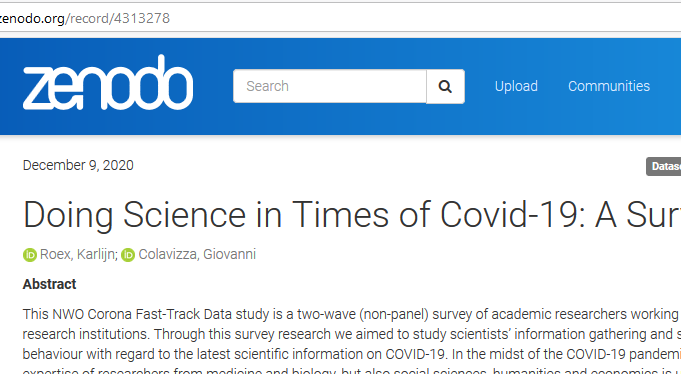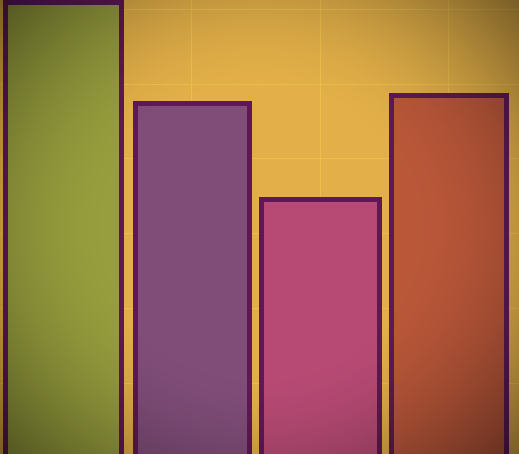The SARS-CoV-2 pandemic generated an ‘infodemic’: an overabundance of often contradictory or fake information. Scientists play an important role in generating reliable information and in informing the public. We assessed their reaction to this ‘infodemic’, and the role they are playing to counteract it.
By collecting survey responses so timely during the pandemic, we were able to build a database with valuable and otherwise lost data. Between 9 June and 31 August 2020, we collected 777 survey responses. In this blogpost we present the first descriptive results, focusing on the demographics of our sample of researchers.
Background
Since the SARS-CoV-2 pandemic took off, scientific research has gained a record visibility. Already in the first months on Twitter, scientific work that is related to COVID-19 had received nearly 1.4 million direct mentions. On these and other platforms, misinformation and fake news are spreading fast as well. It appears evident that we are not only facing a global pandemic, but also a global ‘infodemic’. Combining their knowledge with an intensified visibility during a global crisis, scientists play a key role in ensuring the diffusion of credible information, relevant in this global pandemic. Immediately after the first peak of the pandemic, in the Summer of 2020, we have conducted a survey amongst Netherlands-based academic researchers, to better understand their reaction to the ‘infodemic’. We wanted to explore the following questions: How did researchers gather the latest scientific work on COVID-19? How did they keep up-to-date? How did they communicate scientific results and address online misinformation?
Who are our respondents?
Of all the 777 respondents, 552 completed the survey fully (71%). For the current analyses, we omitted respondents that quit before completing the first quarter of the survey (losing 131 respondents, with 646 remaining).
The resulting working sample is strongly representative with respect to academic position and age. Starting with age (N = 494), we see that people in their late-twenties (25-29) comprised the largest relative group in our sample (28.1%), followed by those in their early-thirties (18.6%) and late-thirties (11.7%). The smallest group of respondents comprised those over 70 (1%), those over 65 and those under 25 (each 3%). This closely resembles the age distribution within the Netherlands-based academic community. Figure 1 shows the proportions of age-groups in our own sample compared to the Rathenau Institute statistics about the research population of the Netherlands (Cijfers over universitair personeel, WOPI, Rathenau Instituut, 2019 and Het personeel bij de universitair medische centra, Rathenau Instituut, 2020).
Figure 1. Age distribution of sample and research population 1
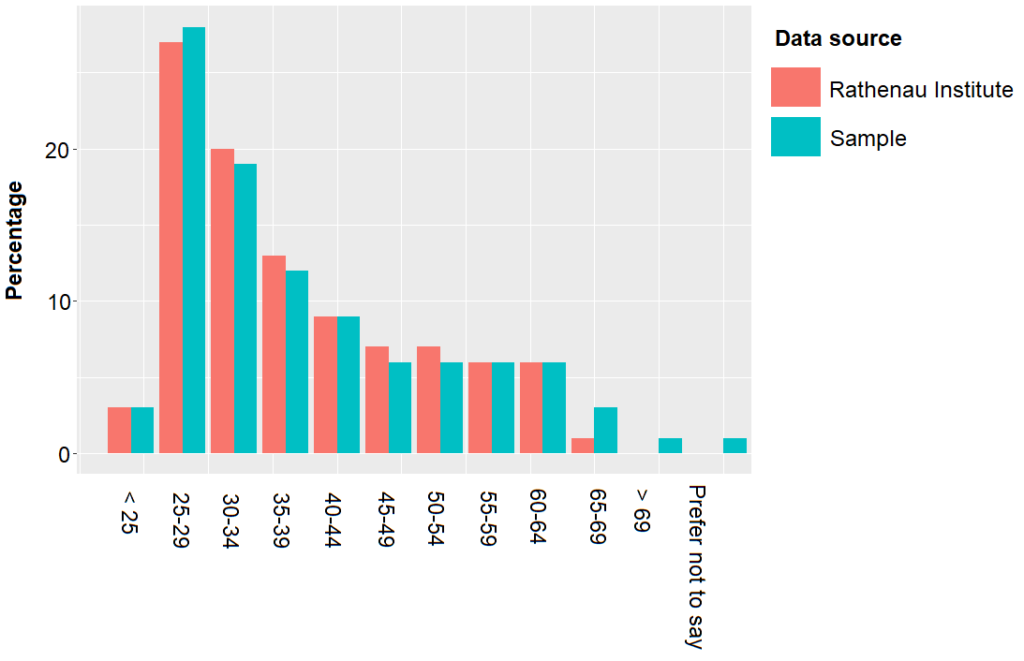
Regarding academic position (N = 590), as much as 38.6% of our respondents were PhD candidates. This is only a small over-representation, as PhD candidates also form the largest professional group in Dutch academia (32.3%). They are followed by assistant professors, the second-largest group. They comprise one-fifth of our sample and the research population (19.8% and 19.9% respectively). Postdoctoral researchers are a relatively small group (approx. 13%). Only 10% of the academic researchers is a full professor, both in our sample as in actual society. Table 2 shows the distributions of academic position for both our sample and the Rathenau Institute statistics.
Table 2. Sample and population distributions in academic position2
| Full professor | Associate professor | Assistant professor | Postdoc | PhD | Retired, active in research | Retired, not active in research | Other | |
|---|---|---|---|---|---|---|---|---|
| Sample | 9.5% | 7.5% | 19.8% | 12.9% | 38.6% | 1.7% | 1% | 9.5% |
| Rathenau | 10.9% | 9.2% | 19.9% | 13.7% | 32.7% | 0% | 0% | 13.7% |
Our sample is less representative regarding research institutes (N = 479). This appears to be directly connected to our sampling process. For some universities, we directly emailed researchers of multiple faculties, asking them to participate in our survey. This led to an over-representation of these universities in the survey sample. Utrecht University, Tilburg University, Eindhoven University are clearly over-represented. For other universities, we only contacted email addresses of the medical center (such as Erasmus MC). Scholars of the University of Amsterdam and Leiden University also received our survey invitation through newsletters or blogposts. These two research institutes were adequately represented in the total sample, as well as Erasmus University (all approximately 9% in the sample and in the research population). Stronger under-representation is due to not having received any recruitment method at all – such as was the case for Wageningen University or Delft University, among others.
Women are over-represented
Finally, our sample clearly over-represents women. Whereas 50.2% of our respondents were women, only 39.5% of Netherlands-based academic researchers are female. As PhD candidates comprise the largest group in our survey, one could conjecture that this explains the high proportion of women. There are many more women among PhD candidates (43.0%) than among full professors (23.1%). Yet, as seen, the presence of the different academic positions in our survey neatly resembles their relative size in the wider Dutch academic community. Therefore, we also would expect a similar gender distribution as in the population (with 39.5% women and not 50.2%). It is longer known that women have a higher tendency than men to respond to surveys (e.g. Dunn et al. 2004; Kalmijn &Liefbroer 2011; Slauson-Blevins & Johnson 2016).
Of our sample, 579 respondents indicated their field of study when asked to choose among six broad categories. The largest category in our sample are the Natural Sciences and Mathematics, with 35.1% of our respondents working in these fields. More than a quarter (26.8%) of the respondents works in Health Studies and Medical Sciences. Also substantial is the share of Social Science scholars (17.6%). Slightly more than one-tenth of our sample works in the Humanities (12.1%). Finally, the smallest category in our sample are Business and Economics (5.5%), Law and Legal Studies (2.9%). Figure 2 shows the relative presence of each academic field.
Figure 2. Sample distribution by academic field

One in four researchers is active on COVID-19
We also asked respondents whether they have been conducting academic research that was COVID-19 related. We received 585 replies. A quarter (24.4%) answered affirmatively, whereas the other three-quarter (75.6%) indicated they had not. Among this quarter that studied COVID-19 related questions (N = 143), a small minority indicated they had studied problems related to pandemics or coronaviruses before the global outbreak. In other words: 16.1% of the respondents that actively researches COVID-19 related questions, had already been studying such topics before the official WHO-declared start of the SARS-CoV-2 pandemic. Perhaps not surprisingly, these 23 scholars were predominantly working in the Natural Sciences and Mathematics (43.5%) – mostly Cellular, Molecular Biology and Microbiological Sciences, Immunology (each 30%).
Another highly represented field was Health Studies and Medical Sciences (34.8%) – almost all Public Health and Health Services scholars (85.7%). Note that these percentages are highly sensitive to low numbers (we are speaking of 8 Health Studies and Medical Sciences scholars). Figure 3 displays the relative presence of academic fields among the 585 respondents, divided into those studying COVID-19-related issues before the pandemic, since the pandemic, and those who do not work on COVID-19 or anything related.
Figure 3. Presence of academic fields divided by topical focus (COVID-19 or not COVID-19)
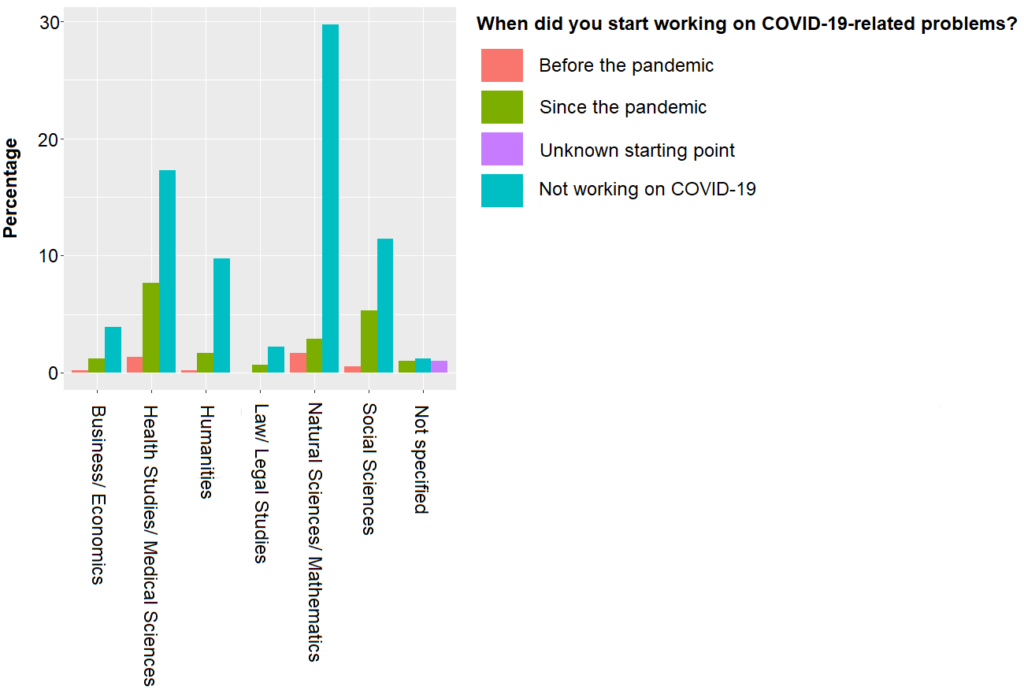
Of these 23 researchers already studying COVID-19 related problems before the pandemic, 6 are full professors (26.1%), 3 are associate professors (13.0%), 6 assistant professors (26.1%), 1 postdoc (4.3%), and 2 PhD candidates (8.7%). Others were retired or in ‘other’ – unspecified – career stages. By contrast, as much as 120 respondents (83.9% of all those working on COVID-19 related research) are new to these questions. Among these ‘new COVID-19-researchers’, there were slightly fewer full professors (N = 17; 14.2%) and notably more postdocs (N = 18; 15.0%) and PhD candidates (N = 32; 26,7%). Moreover, there were 11 associate professors (9.2%) and 26 assistant professors (21.7%) in this group.
Scholars who have been studying COVID-19 related topics already before the pandemic are most often active in Public Health, Cellular Biology or Microbiology/ Immunology. Newcomers are often from Health Studies, Medical Sciences and Social Sciences.
Similar as for the researchers already working on COVID-19 related topics, ‘new COVID-19-researchers’ are relatively often working in Health Studies and Medical Sciences (38.1% of those new to COVID-19 research). What is different about this new group, is the substantial presence of social sciences. More than a quarter (26.3%) of scholars is from social science disciplines. Regardless of their discipline, most of the ‘new COVID-19-researchers’ started researching their topic in March or April. It appears that many scholars managed to respond quite early in the pandemic, shifting their research efforts.
Regardless of when people started, the two academic fields that are most represented in COVID-19-related research (N = 574) are Health Studies and Medical Sciences and Social Sciences. More than a third of the scholars (34%) in each field had been undertaking COVID-19 related research. Surprisingly, only 13% of the scholars in Natural Sciences and Mathematics (among which many biological sciences) are conducing COVID-19 related work. The percentages for Law and Legal Studies and Business and Economics are notably high, but this is likely due to their small sample size.
Zooming in on sub-disciplines
Now we take a closer look at sub-disciplines. In the part of Health Studies and Medical Sciences that is involved in COVID-19 research (N = 74), two disciplines stand out in size: Clinical Medicine (44.7%), Public Health and Health Services (36.2%). Notably, one-tenth of COVID-19 related research within Health Studies and Medical Sciences can be classified as Clinical Psychology, Psychiatry or Neuroscience (10.6%). Figure 4 displays the share (in percentage) of these Health Studies and Medical Sciences disciplines within the total group of ‘COVID-19-researchers’ (N = 143) and those that do not work on COVID-19 (N = 442) respectively.
Figure 4. Presence of medical (sub)disciplines among scholars working on COVID-19 or other topics

Among the Social Sciences scholars working on COVID-19 related questions (N = 32), psychologists comprised the largest share (37.5%). A quarter of these social science scholars were sociologists (25%), and another substantial share were political scientists (18.8%). Figure 5 shows the share of the different social science disciplines within the total pool of COVID-19-researchers.
Figure 5. Presence of social science (sub)disciplines among scholars working on COVID-19 or other topics
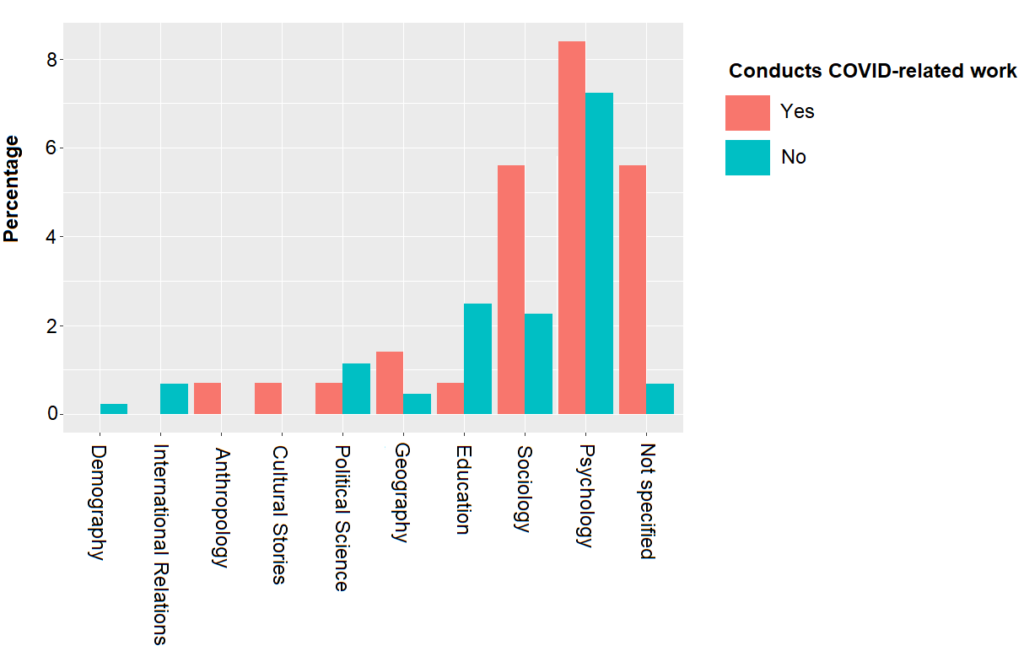
Finally, within the small Natural Sciences and Mathematics part that is devoted to COVID-19-related research (N = 27), two predictable sub-disciplines dominate: Cellular and Molecular Biology (22.2%) and Microbiology and Immunology (18.5%). However, their numbers remain low (around N = 6 for each discipline or sub-discipline). This is indicated by the low portion that these sub-disciplines (below 8%) take in the total group of COVID-19-researchers in Figure 6.
Figure 6. Presence of natural sciences or mathematics (sub)disciplines among scholars working on COVID-19 or other topics

Also notable is the large presence of women among those that work on COVID-19. Among COVID-19-researchers that answered our gender question (N = 124), 61.3% were women. Please note that our result may also be explained by the overall over-representation of women in our survey. Yet, an odds ratio – which accounts for the different sample sizes of men and women – reveals that women are almost twice as likely to be working on COVID-19 than men (OR = 1.81). This finding is striking, since earlier research shows a high under-representation of women in published scientific work on COVID-19 (see papers here and here). In our next blogpost about our data, we will focus more on interesting gender differences and information behaviour.
Next steps
We will now move into deeper analyses3. Moreover, we plan to conduct a second round of the survey, starting later this month. Further updates on our project will follow on our website. Feel free to contact Karlijn Roex for further information: k.l.a.roex@uva.nl. We hope that our unique data and deeper analyses will help different parties with improving science communication, open science practices and misinformation interventions.
- Rathenau Institute (research population data) only has a ‘65 and older’ category, without distinguishing people older than 69. This total group was here attributed to the 65-69 group.
- Rathenau does not distinguish a ‘postdoctoral’ category, only a ‘other scientists’ category. For the current analyses, it was assumed that 50% of these ‘other scientists’ were postdoctoral researchers. The other 50% was assumed to correspond with our survey-category ‘other’.
- In order to make valid inferences about the wider research population in the Netherlands, we are developing survey weights in order to account for different sampling probabilities. This was not done yet for the present descriptive analyses – so caution in making broader inferences is warranted.


